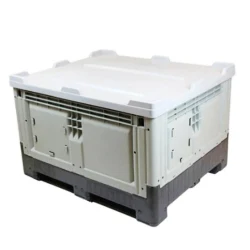Applications of Forklift Bulk Containers
2024-05-17
Forklift bulk containers, also known as forklift bins or forklift bulk boxes, are large, durable containers designed for handling and transporting bulk materials with the use of a forklift. These containers are widely used in various industries, including agriculture, manufacturing, logistics, and warehousing, to efficiently manage and move large quantities of goods.
Key Features
1. Material:
- Plastic: Most common, typically made from high-density polyethylene (HDPE) or polypropylene (PP). These materials are durable, lightweight, and resistant to corrosion and impact.
- Metal: Made from steel or aluminum, offering higher strength and durability for heavy-duty applications.
- Wood: Less common but used in some industries for specific applications.
2. Design:
- Stackable: Many bulk containers are designed to be stackable, maximizing storage space in warehouses and during transport.
- Collapsible/Foldable: Some models can be collapsed or folded when empty to save space.
- Ventilated: Containers used for agricultural products often have ventilated sides and bases to allow air circulation and prevent spoilage.
3. Capacity:
- Volume: Ranges from small containers of around 200 liters to large ones exceeding 1,200 liters.
- Load Capacity: Typically can handle weights from 200 kg up to several tons, depending on the material and design.
4. Accessibility:
- Drop Gates/Doors: Some containers feature drop gates or side doors for easier access to contents without having to unload the entire container.
- Forklift Pockets: Designed with slots or pockets for forklift tines, ensuring secure lifting and transport.
5. Customization:
- Color-Coding: Available in various colors for easy identification and sorting.
- Label Holders: Some models include label holders for better organization and tracking.
Applications
1. Agriculture:
- Used for harvesting, storing, and transporting fruits, vegetables, and other produce. Ventilated models help maintain product freshness.
2. Manufacturing:
- Ideal for transporting raw materials, components, and finished goods within a factory or to external locations.
3. Warehousing and Logistics:
- Streamline the movement and storage of bulk goods, facilitating efficient inventory management and reducing handling times.
4. Recycling and Waste Management:
- Employed for collecting and transporting recyclable materials or industrial waste, ensuring safe and efficient handling.
Advantages
- Durability: Built to withstand heavy use and harsh environments.
- Efficiency: Facilitate the quick and easy movement of bulk goods, reducing labor costs and improving workflow.
- Space-Saving: Stackable and collapsible options help maximize storage space.
- Safety: Designed to securely hold and transport heavy loads, minimizing the risk of accidents and product damage.
Maintenance and Care
1. Cleaning: Regularly clean containers to prevent contamination and maintain hygiene, especially in food-related applications.
2. Inspection: Periodically inspect for cracks, deformations, or other damage that could compromise the container's integrity.
3. Proper Handling: Ensure forklifts are operated correctly to avoid damaging containers during lifting and transport.
Leading Brands
- Orbis Corporation: Known for high-quality plastic bulk containers with a variety of features.
- Schoeller Allibert: Offers a wide range of durable, stackable, and collapsible containers.
- Buckhorn: Provides innovative solutions for bulk material handling with an emphasis on versatility and durability.
- CHEP: Supplies reusable containers that are ideal for supply chain efficiency and sustainability.
In summary, forklift bulk containers are indispensable tools for efficient material handling across various industries. By selecting the right type and maintaining them properly, businesses can significantly enhance their operational efficiency and safety.



